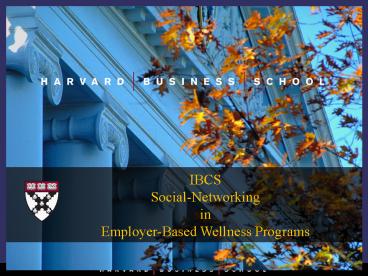Project Deliverables PowerPoint PPT Presentation
1 / 17
Title: Project Deliverables
1
IBCSSocial-Networking in Employer-Based
Wellness Programs
2
Chronic Health Problems
- Chronic diseases are the 1 causes of MM in
industrial world (Obesity, Lung Disease,
Diabetes, CAD/CVA) - Most of these diseases are related to behavior
(smoking, inactivity, diet) - Large Proportion of them are preventable.
3
Wellness Programs
- Employers or insurance cos sponsor programs to
improve wellness through health-living behaviors
(exercise, diet, smoking cessation) - Reasons
- Improve productivity
- Lower healthcare costs
- Enhance your corporate image and long-term
interests by promoting health beyond the worksite - Help the nation achieve its health objective for
the year 2010
Ref Healthy Workforce 2010 An Essential Health
Promotion Sourcebook for Employers, Large and
Small http//www.prevent.org/images/stories/File
s/publications/Healthy_Workforce_2010.pdf
4
Social Network targeting behavior
- Social interactions influence human behavior
- Social network identify represent maps of
interactions - Social network targeting could increase
cost-effectiveness of health behavior
interventions
5
Market Workplace Health Programs (2004)
Other large small businesses with lt50 employees
5.89 million
Total of WHP (gt50 employees)
330,087
Smoking cessation /or phys activity
126,118
Employee interest in programs
80,186
- Growth 7
- Initial Market Value
- Total WHI 41.9b
- Target market 5.6b
Without an improvement plan
44,115
6
Competition IP Status
- IP
- Competition
- Many companies offer wellness programs
- None utilize Christakis
- Social-Network targeting
- No direct competitors
- Avoid by consulting to wellness programs, insur co
- Filed Patent Application 2007
- Some prior art
- If patent issued in 1-3 years, will be weak,
computer business-process patent - Protection thru trade-secreted software
expert-analysis
7
Business Model
- Recommendation pursue
- Path to market License to start-up
- Start-up would be consulting company, initially
to - Insurance Run, Employer-targeted Wellness/Health
Program - Use invention to provide more cost-effective
wellness and health interventions
8
Status
- Stage of development Idea/Proof of Concept
- Technically feasible? Yes, but will require much
work - Technical roadmap
- Build network analysis requirements (info,
importation of data) - Develop software link to both employer
insurance data - Analyze sample networks with software
- Risks
- Can we get sufficient info to build rich networks
- Privacy/confidentiality concerns of peoples data
- Will Social-Networking targeted interventions
work more effectively?
9
Go To Market Strategy
- Business feasible?
- Roadmap
- Identify and sell to corporate partner
- Procure funding from corporate partner
- Build analysis tools do pilot
- Prove effectiveness
- Identify Insurance Run, Employer-based Wellness
Program to partner pilot - Health insurance (e.g. Harvard Pilgrim, Vanguard,
BCBS) - Build SN analysis software and provide consulting
services for tailored SN-targeted intervention - Measure costs and outcomes
10
Thank you!
- Alvin Yu
- Harvard Medical School
- Marie-France Hivert, M.D.
- Massachusetts General Hospital/Clinical Scholars
Program - Yuri Maricich, M.D.
- Harvard Business School
11
Back up Slides
12
Challenge requires change in behavior
- Even with the gold-standard intervention for
behaviors change (one-to-one counseling), many
individuals are not successful at achieving their
goal - For example in the Diabetes Prevention Program,
after 3 years of intervention, only 38 of the
participants had lost and maintain ?7 of weight
loss - Worksite wellness programs have tried to
increase and maintain participation or goal
achievement by use of incentives (money, raffles,
gifts), but there is still a lot a room for
improvement - Cost
13
Employer-Based Wellness Programs Benefits
- Improve productivity
- Attracting superlative workers in a competitive
global marketplace - Reducing absenteeism/lost time
- Improving on-the-job decision-making and time
utilization - Improving employee morale and fostering stronger
organizational commitments - Reducing organizational conflict by building a
reservoir of good-will toward management - Reducing employee turnover
14
Employer-Based Wellness Programs Benefits
- For the employees
- Improve the physical health, stamina, and general
wellbeing - Improving their focus at work
- Increasing job satisfaction and fostering
positive outlook on life - Bettering relations with co-workers and
supervisors
15
Employer-Based Wellness Programs Benefits
- Lower healthcare costs
- Unhealthy behavior cost more
- Smokers generated 31 higher claims costs than
non-smokers - Workers with unhealthy weights had 143 higher
hospital inpatient utilization than those with
healthy weights - For each dollar spend on health promotion 3.35
save in healthcare expenses
16
Employer-Based Wellness Programs Benefits
- Enhance your corporate image and long-term
interests by promoting health beyond the worksite - Building a healthy community (pool of healthy
future employees, current employees and family
healthier) - Demonstrating social responsibility
- Building public goodwill and a reputation as a
good corporate citizen - Directly and indirectly promoting the health of
company employees, retirees, employees families,
consumers, and/or service providers- all of whom
can have an impact on a business long-term
success
17
Employer-Based Wellness Programs Benefits
- Help the nation achieve its health objective for
the year 2010 - Have 75 of employers offering a wellness program
- Have 75 of employees participating in wellness
program when available on worksite - Recommendations for major focus of wellness
programs should be - Tobacco use
- Alcohol/drug use
- Physical inactivity
- Overweight/obesity

